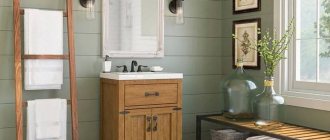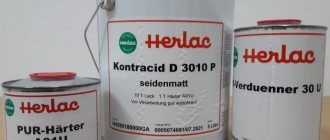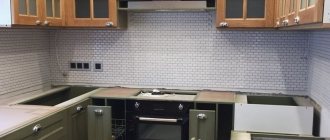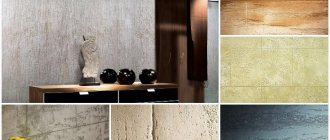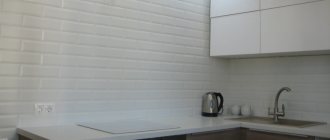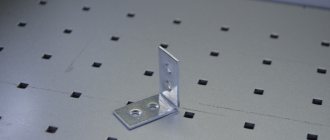Types of grout for tiles
Traditional option. This type of grout is made of cement and sand and is used most often. All thanks to the availability and low price of raw materials, as well as durability and strength. It should fill seams from three to five millimeters.
Sometimes this composition is supplemented with stabilizers and plasticizers. The latex base allows for greater moisture resistance.
Color grout
So, if you didn’t worry enough in the process of choosing the color scheme of the tiles, then choosing the shade of the grout will more than make up for these worries.
That's why. For example, slight changes in the tone of even ordinary gray grout can affect the appearance of the entire mosaic. First of all, you need to decide whether you want the color of the grout to contrast with the color of the tile, to unite the elements or, on the contrary, to separate them, which will ultimately either soften the image or make the mosaic clearer. The picture above shows how using different shades of gray changes the appearance of the project. The drawing in all the pictures is the same. The only difference is the color of the grout.
Notice this difference and how the different grout colors look directly in the colored mosaic example.
Example of real mosaic and grout Notice how the color of the grout changes the appearance of the mosaic
| White grout | Light gray | Dark gray | Coal |
Examples of mosaics - the pattern is the same, only the colors of the grout differ. The samples are placed side by side, the lighting is the same.
If you cannot decide which color is best suited to realize your idea, then it is best to make similar samples. Glue the tiles to a piece of wood and apply different colors of grout. This will help you make your choice.
So which color is better? It depends on what your mosaic looks like. Most often they use light gray, dark gray and less often - charcoal or black. Try to avoid white, it will often make the mosaic look dull. In any case, make samples with colors that you might like; if in the end you are not satisfied with any option, use a moderate sulfur.
Using colored grout
The difficulty with using colored grout is that the wrong color can ruin a perfectly laid mosaic, but once you feel more confident, try using russets, dark blues and dark greens.
The picture above is an example of the impact that colored grout can have on the overall appearance of the mosaic. Again, the only difference is the color of the grout.
An unusual result of using grout of different colors in one mosaic
If you're really into it, it's worth trying different grout colors in one mosaic. There will be more work, but the result will be incredible. Even subtle changes in color can create a noticeable effect. The photo below shows a wall mosaic. The seams on the wings of the butterfly and dragonfly are treated with black grout, and all the rest are treated with a moderate gray shade. Thanks to this, the grass and sky appear lighter, a single image is obtained, and the illusion of wing mobility is created.
To do this, cover those parts of the mosaic that will have a different color grout, apply regular grout first, let it dry, then move on to the next area. There will be more work, but the effort will be rewarded.
Why do customers choose our store? Read reviews:
Often during renovations, grouting is the last thing people remember, but in vain. Not only the service life of the mosaic panel depends on its choice, but also how spectacular previously unremarkable surfaces will become. We will tell you in more detail using the example of projects by Russian designers.
Cement grout for mosaic tiles
Cement grout is worth choosing because of its affordable price, ease of use, and easy removal of excess material from the mosaic.
This grout should not be used in a room with high humidity, because it is not moisture resistant enough. The texture of the grout is quite porous, dirt and dust accumulate in it.
Possible mistakes
The most likely violations include failure to comply with the proportions of components, choosing the wrong tool, and untimely removal of excess. The first mistake leads to a decrease in the quality of the working mass. The second mistake delays and complicates the process of filling tile joints and negatively affects the overall quality of the finishing of the facing coating. The third point is that residual plaque cannot be completely eliminated, but hardened stains will be more noticeable and are also difficult to remove later.
Epoxy grout for mosaic tiles
Another type of material has been used not so long ago, but has already become popular. Very durable and aesthetic grout. It is a two-component product, when you get started, first mix all the components with the catalyst, packaged separately.
- This speeds up the curing process and fills the joints quickly.
- The mixture itself is transparent, but you can color it or add glitter.
- This way you can experiment with interior design.
Wear-resistant and durable, perfect if the surface is exposed to intense sunlight. However, skill and experience working with such material is required to create a real masterpiece.
This grout dries instantly and hardens after fifteen to twenty minutes. The material is quite expensive, although it won’t take very long to update it. Be sure to ventilate the room well when working, otherwise poisoning may occur.
Grout, which is correctly selected according to the color scheme, will help to emphasize the beauty of the design and give it completeness.
How to care for seams: tips
The surface must be periodically cleaned of dust and other contaminants. It is necessary to remember: clean seams are the key to ensuring that harmful bacteria will not multiply on the coating. It is necessary to clean it several times a month. For these purposes, use soap solution, vinegar, citric acid or household disinfectants.
You can bleach the surface with peroxide and soda, and disinfect it with bleach. The seams can be washed with a toothbrush, and dirt can be removed and germs destroyed with a steam cleaner. If the light seams have darkened, it means that fungus has formed on them. In this case, you need to clean the old layer and treat the coating with an antiseptic, and then apply a new solution.
Grout color for mosaic tiles
To add harmony to the composition, choose a grout that is one or more shades darker than the mosaic. Light colors are not suitable for kitchen surfaces and floor coverings, because they will quickly become dirty.
Colorless epoxy grout is what is suitable if the mosaic is glass or photo panels are used. The appearance of grout should always be assessed on a small area before applying to the entire area.
Recommendations
To properly grout the seams, you need to consider the following tips:
- The mosaic needs to be washed several times.
- If it is not possible to choose the desired shade, white grout is a mixture that can be combined with almost any mosaic.
- The area processed at a time should not exceed 2 m2.
- Before grouting the mosaic, you need to experiment with applying it on an inconspicuous area.
- During the work, the tiles may move out. To fix it, you need to move the edge of the mosaic with a spatula. The main thing is that the mixture does not have time to harden, otherwise the material will have to be dismantled and re-installed.
- It is recommended to grout the seams of glass mosaics with a colorless solution, since it will not stand out. This way the coating will gain integrity.
- Epoxy grout is easier to clean if you pre-treat the surface with a product that forms a protective film.
Grout shade options
There are many color options, especially for epoxy grout. The compositions can even have golden and black colors.
However, it is important to remember that grout is necessary to emphasize the advantages of the mosaic composition; this material does not play a leading role.
Mixtures with plasticizer
Cement grouts with a plasticizer are ready-made cement mortars enriched with polymer modifiers that increase the elasticity of the joint, they harden quickly enough and are easy to keep clean, and specially selected fillers reduce the porosity of joints at the joints; Such building mixtures can be considered more universal than cement. As a rule, they are used to fill both thin and thick joints inside and outside the building; they can be used on deformable substrates such as chipboard, plasterboard, as well as on terraces and balconies; they are also suitable for treating heated floors. Such elastic grouts are frost- and water-resistant, but should not be considered waterproof (take this nuance into account, it is very important!).
Selecting grout composition
In order to correctly decide on the choice of grout for mosaics, you need to consider several points:
- Assess what type of room it is. Typically, mosaics are used in rooms where the level of humidity is high - a swimming pool or a bathroom.
- In addition, this is an excellent option for designing a fireplace, flooring, and wall decoration.
- Use mosaic elements to decorate your garden plot; bright patterns will fit perfectly into the design of paths and ponds in the garden.
- The epoxy version of the grout will protect the mosaic from the effects of fungus and moisture for a long time.
- Sand and cement grout will perfectly serve as decoration in rooms where there is an optimal level of humidity for decorating walls.
It is quite popular to use not only colored, but also transparent grout. It looks great with mosaics decorated like marble or having a mirror surface. It is important to evaluate the durability of the grout.
In this case, epoxy wins. Despite the fact that the material is expensive, it will last for several years. Pay attention to the brand name - various components can be added to different grouts.
They improve the physical and mechanical properties of the composition, working with such material becomes easier, and consumption is reduced. The ability to easily clean the mosaic surface from residues of the composition is also an important quality.
The room temperature mode affects which composition to choose. Epoxy grout is easier to use in hot weather conditions. The cement mixture is perfect for rooms with lower temperatures.
How to clean and protect tiles from fungus and dirt?
Among the protective agents for tiles and mosaics we can recommend:
- water repellents - impregnations with moisture-repellent properties that create a thin protective layer on the seams;
- polymer varnish for the space between tiles - penetrates into the depth of the grout, creating a more durable protective layer that collects drops on its surface;
- silicone or acrylic sealants - used in “problem” areas where contact with water is most likely (corner seams, areas near the sink, bathroom, plumbing fixtures).
Seams protected from moisture will not accumulate bacteria and fungus. To protect against mold, fungicides are also added to the grout, which do not give the fungus a chance to grow.
If the fungus still prevails, and unpleasant stains of dirt appear on the seams, the following will help:
- white vinegar - spray it onto the seams, leave until dry, and then remove dirt with a brush;
- hydrogen peroxide - the algorithm of use is similar to vinegar;
- tea tree oil – 1 tsp. dilute in a glass of water, spray on the seams, do not rinse;
- furatsilin – 1 tablet, dissolved in a liter of water, apply and thoroughly wash the seams;
- household chemicals – chlorine-containing and anti-mold agents such as “Isocid”, DALI, “Antifungal”, “Mill Kill”.
Read more about how to remove mold from tile joints in this article.
Grout consumption per 1m2
The consumption of materials will vary depending on mosaic parameters such as length, width, and height of the elements. Another important feature is the width of the seam running between the tiles.
- Often the packaging indicates the approximate consumption of grout.
- The entire volume of materials must be from the same production batch specified by the manufacturers.
- The qualifications of the master will determine how well and accurately the work will be done.
To carry out repair work yourself, you must have relevant experience. You can replace the damaged element yourself and repair the damaged finish after some time.
Mosaic grout has many features regarding composition, design and conditions of use. It is important to consider the functions, area of the room, as well as the style in which the interior is designed.
When choosing a more expensive epoxy grout, you can be sure that repairs will not be needed for very long. You should not choose cement grout for a room that is often exposed to water, fungus, and dust, but it will perfectly help you decorate a mosaic; you will be pleased with its affordable price and ease of use.
Application process: instructions
Work can begin after 24 hours from the date of laying the tiles. This time is enough for the glue on which the facing material was attached to completely harden. This requirement should not be neglected, otherwise moisture will destroy the mixture with which the seams are filled. The craftsmen have come up with the best method for grouting the seams on a mosaic:
- There should be no tile adhesive residue on the wall, so the surface must be treated with an acid cleaner.
- Wipe the mosaic with a sponge or terry towel.
- Mix the solution according to the instructions on the package.
- Rub the seams with the prepared mixture, moving diagonally from top to bottom. The main thing is to fill all the seams at once.
- Remove excess solution with a rubber spatula.
- After some time (usually the drying time of the mixture is 30 minutes), wash the tiles. To complete this step, you need to wipe the mosaic with a cellulose sponge to remove excess solution.
- Wait a few days. During this time, the coating must be protected from drafts, moisture, UV rays and temperature changes.
- Wipe the surface with a foam float.
To prevent cracks from forming, during the work you need to moisten the seams with water using a spray bottle.
Photo of grout for mosaic tiles
Specifications
The Litokol brand grout mixture is a special epoxy, cement or polyurethane material that seals the seams between the tile elements, sealing the surface from moisture and various dirt. Available in a wide range of colors to match many types of tiles and porcelain stoneware. The joint sealer has the following characteristics:
- low abrasion coefficient;
- used at temperatures not lower than -20 degrees;
- when frozen, withstands temperatures up to 100 degrees;
- not prone to mechanical stress by compression and bending;
- is resistant to UV rays;
- due to the presence of shiny components (in some types and epoxy), it additionally decorates the surface;
- After hardening, it withstands acidic and alkaline environments.
What are the types of grout mixtures: types, differences, pros and cons
The most common are dry mixtures. Manufacturers use cement with various additives as their base; they make the grout plastic, easy to use, water-repellent, etc. The powder can be used only after dilution (water, less often liquid latex), the proportions are always indicated on the packaging.
There are also synthetic types. They are immediately ready for use; usually you don’t need to add anything, but there are also those that require mixing with a hardener or dye.
In any case, the action is approximately the same: the mass is introduced into the spaces between the tiles, hardens, fastening the edges together. The result is a thick protective layer that does not allow moisture and air to destroy the integrity of the cladding.
Cement grouts
This type includes all grouting masses, the basis of which is a cement-sand or cement-polymer mixture. The composition allows you to use this option for gaps of different depths and widths. The affordable price makes this type the most popular and widespread.
| pros | Minuses |
| Relatively low price. | Poor color palette due to the properties of the base material. |
| High strength, resistance to washout. | It takes a very long time to dry and shrinks slightly after drying completely. |
| It takes a long time to harden, but if the work was done with flaws, you can correct them without consequences. | The porous structure makes it impossible to use cement grout without antiseptic substances in a damp room (bathroom, bathhouse, etc.). |
| Easy to fix if the seam breaks over time. |
| pros | Minuses |
| 100% waterproof. Zero porosity, which means neither dirt nor moisture is a problem. | Significantly more expensive than other options. Often it is the high cost that cancels out all the many advantages. |
| Suitable for rooms that require frequent disinfection with strong detergents. Not afraid of powders or rough cleaning. | The mixture is easy to prepare, but working with it requires skill. You cannot hesitate and make mistakes, since the rate of hardening is very high. |
| For such grouts, neither open fire nor icy wind is dangerous. No temperature changes will affect the color. Manufacturers guarantee the safety of the coating for at least 30-50 years. | Slight surface roughness (due to fine sand in the composition) can create inconvenience, for example, when cleaning. |
| It can take on any color and highlight the most unexpected interior design. Sequins, rhinestones, luminescent glow? | Furan grout is not safe and cannot be used in apartments and houses where people and animals live. Only production premises with good ventilation. |
Silicone grout
Another type of grout that is ideal for fine work. The silicone base does not allow moisture or air to pass through, adheres well and is not destroyed when exposed to most modern detergents (except chlorine).
We invite you to find out which self-leveling floor is better
| pros | Minuses |
| The grout is relatively easy to work with and hardens quite slowly, allowing you to correct any unevenness. | When disinfected with chlorine products, it is gradually destroyed. |
| If necessary, it can be easily removed without leaving any traces. | |
| Suitable for wet areas, strong and durable. |
Latex grout
One of the expensive mixtures, which is usually not used in its pure form. Latex grout is purchased either to dilute the cement base, or is applied to the finished, dried seam after shrinkage. The latex finish significantly increases the wear resistance of cement grout and makes it waterproof.
| pros | Minuses |
| Good elasticity makes the latex grout mixture durable and not prone to cracking. | Expensive. |
| Suitable for wide gaps (up to 3 cm). | It is necessary to immediately clean up the flaws, otherwise the tile will become cloudy forever in the place where the mixture has dried. |
| Lots of shades. Hundreds of color options available. |
About prices
| Rub over the mosaic sheet with 4 basic colors: (we keep the sheet). | 3000 rubles |
| Grind the mosaic sheet using our grout tinting system: | 5000 rubles per sheet. |
| Cost of transparent grout: | 2000 rubles per 1 kg. |
| Consumption of transparent grout: | 1 kg per 1 square meter. |
| Acid cocktail: | 15,000 rubles for 2 liters. |
| Glowing Additive: | 6000 rubles for 1 pack. |
| The cost of grouting mosaic joints with transparent grout is: | 6000 rubles per square meter. |
| The cost of grouting tile joints with transparent grout is: | 5000 rubles per square meter. |
| Visit of a master consultant: | 3000 rubles. |
| Visit of a specialist with all samples to the site: | 7000 rubles. |
